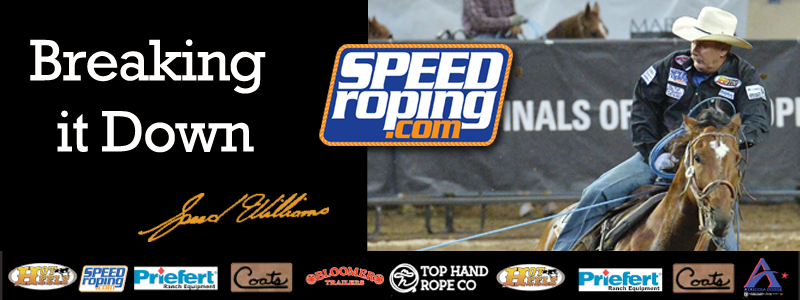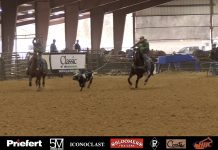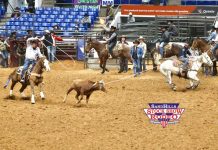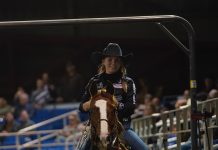Teaching my son to heel

Teaching my son to heel has been fun for me because I grew up heeling and I’m able to simplify much of it for him. For me, it’s math equations that determine why people have good days, bad days, or why they get along well with some horses and not others. Growing up, when I got home from school my dad would have three or four heel horses saddled. I roped all day until we were done, cow after cow. And as a kid I won pretty much everything back east. When I was 13 or 14, when we would show up to a roping and they would tell my dad I could enter heading, but not heeling. I’ll never forget the heartbreak in my fathers’ eyes when I came home after my first NFR as a heeler and told him I wanted to start heading. He’d never admit I did the right thing, but he did wear my first gold buckle until he died.
Gabe didn’t have much to do with roping until a year ago. While we were in Vegas he won some money in the dummy jackpots and got hooked. When I say hooked, he sets his alarm for 5:30 a.m. and gets up and does his schoolwork so he can be ready to rope when we start our private lessons at 10 a.m. He doesn’t want to miss any opportunity to rope. I did no5 foresee his want to and desire for roping. It far exceeds my dreams… and wears me out. No matter how many he runs each day, it’s always “one more pen Dad.”
One of the discussions we’ve had is about how he likes to heel with a small loop. Yes, it’s faster and easier to swing but it’s also harder to get your dally. With a bigger loop you have a little more time before it comes tight. He had a break through when he saw himself on video missing his dally with the little loop. I told him, “Son, there’s very few things in heeling I haven’t tried, and many elite heelers I’ve discussed it with. ”
In 1997 I was heading for Clay O’Brien Cooper. We were driving back from Denver and I asked him how he described putting a heel loop under a cow. For a little over two hours he talked in great detail about it. Normally it wasn’t uncommon for us to drive 12 hours and say very little during the entire trip.
The intrigue of the heel loop is a lot like playing golf to me. There are different things you have to do with your hand based on the position and angle of your swing, and the position of the cow to your horse. There are different approaches to heeling steers and many ways that will work if you are in time with the steers’ legs. But to put it simply, you must get the rope behind the front legs, on the ground, in front of the back legs. One thing many heelers struggle with is getting their bottom strand on the ground. When we watch videos of #4 or #5 heelers, they can throw at the correct time but most of them struggle with the bottom strand.
The most common way people learn to heel is by letting their horse stop and then roping the cow as it leaves them. The problem is it’s very hard to get your dally when you’re stopped and the steer is six to eight feet from your horse and moving away.
One thing I have worked with Gabe on is riding a good corner. When you ride a good corner and have your horse in your hand it makes heeling a lot easier. I want him to get close to the cow and place his rope on the ground as he engages the bridle reins. I want him to heel steers right in front of his horses’ front feet. This allows him more time to get a dally. For a long time he heeled with one coil. When he would lose his rope and tell me he needed more rope, I would answer, “No son, I need you to heel the cow closer to you.”
There are many ways to put a heel loop under a cow. I have seen many different deliveries, angles, and swings. There’s good, bad, and just different. Because my dad trained and sold lots of horses I was able to experiment with my heeling. I believe in having every golf club in your arsenal to pull off all the different shots you’ll be presented with.
One of the things Gabe works at on the Speed Trainer is position. A lot of his steers end up to the outside so we practice for that. I move the dummy all around so he gets to practice different heel loops in various situations. I’m a firm believer that heeling a dummy from the ground is mathematically different than from the height and position of a horse – whether it’s live or a dummy. It’s completely different and doesn’t transition well.
I so many different ways that work – but thing that never changes is – you must get your rope on the ground in front of the steers’ front legs without hitting the hind legs. It can be done many different ways but when and how to throw depends on your speed and the distance from the steer.
What’s new with me: Nicer weather means I will be traveling for some clinics. I’m very excited with the progress my kids have made with their roping. Hali was just moved to a #6 header and Gabriel to a #4+ header. I’ve seen a big difference in their riding and how they use their legs and the bridle reins since they’ve been doing their drills on the Speed Trainer. This enables us to target things they need to work on without wearing out steers and horses in the process.






